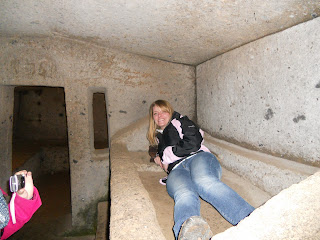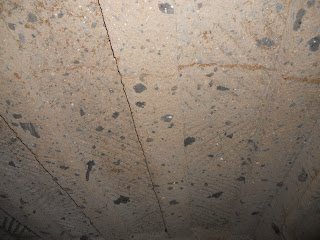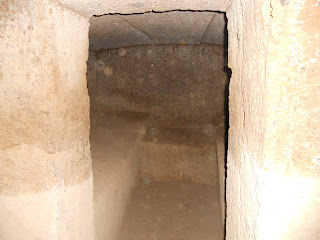Yesterday, the Ancient City Course took a day trip to visit the ancient sites of Tarquinia (also Tarquinia today) and Caere (Cerveteri today). There in Tuscany (Southern Etruria in ancient times), we took a look at the burial tombs of the Etruscans dating anywhere from the 6th-4th centuries B.C. For a long time it was believed that the Etruscans were not an Indo-European group. The reason was that the Etruscan language was vastly different from other Italian groups at the time. However, scientists by looking at the mitochondrial RNA of remains found that the Etruscans indeed show resemblances to Indo-Europeans. The Etruscans are not only famous for being Rome's main enemy through the 5th-3rd centuries B.C. They build wonderful painted chamber tombs. They traded precious metals with the Phoenicians and Greeks for Greek pottery and items. Here are some fotos for you guys:
 |
| Modern Tarquinia |
 |
| Museo in Tarquinia |
 |
| Dan with Ancient Tarquinia behind him on the hill Civita |
 |
| Ancient Tarquinia on Civita |
 |
| Tolfa Hills (at the back)- This is where the Etruscans mined precious metals such as copper in order to trade with the Phoenicians. |
 |
| Tomba Caccia e Pesca |
 |
| Notice the long and winded cats? This is Ionic influence. This dates the tomb to around 6th-4th B.C. since the Etruscans were in contact with the Greeks. |
 |
| The four posts on the rock indicated that a kline was place there on which the body laid. |
 |
| The red lines going vertical indicate posts. This tomb is painted as a hunting tent. |
 |
| A pozza markers. A pozza burials consists of a cremated body. The ashes are put inside an urn in the ground and marked with these rocks that resemble huts. |
 |
| This tomb shows a graphic scene |
 |
| This tomb has 3 doors and multiple scenes of debauchery. It looks like the deceased enjoyed drinking-house parties. |
 |
| The sea off of Tarquinia |
 |
| Etruscan cats of Caere |
 |
| This is Saul in the necropolis of Caere. |
 |
| This is a round tomb of Caere. Its circular shape is created by rock and brick. Its circular shape also demonstrates that the person lived in the 7th century B.C. |
 |
| This is where the body would have lain |
 |
| Look just like beds!!! |
 |
| This tomb resembles a house |
 |
| Brainssss! |
 |
| Someone being very silly |
 |
| AN ETRUSCAN HAND!!!! Nah jk. |
 |
| The tomb of shields and reliefs. A Relief is a sculpture in which the figure pops from a 2-D background. |
 |
| A winding corridor |
 |
| More...Brainssss! |
 |
| Golum! |
 |
| A rectangular tomb dates back to the 5th-6th century B.C |
So I hoped you guys noticed that Etruscan tombs from the 7th-4th century was shaped to resemble an Etruscan house. Furthermore the painted tombs at Tarquinia gave us insight to the life of the deceased. I hope you enjoyed these fotos from the necropolis of Tuscany!


























































No comments:
Post a Comment